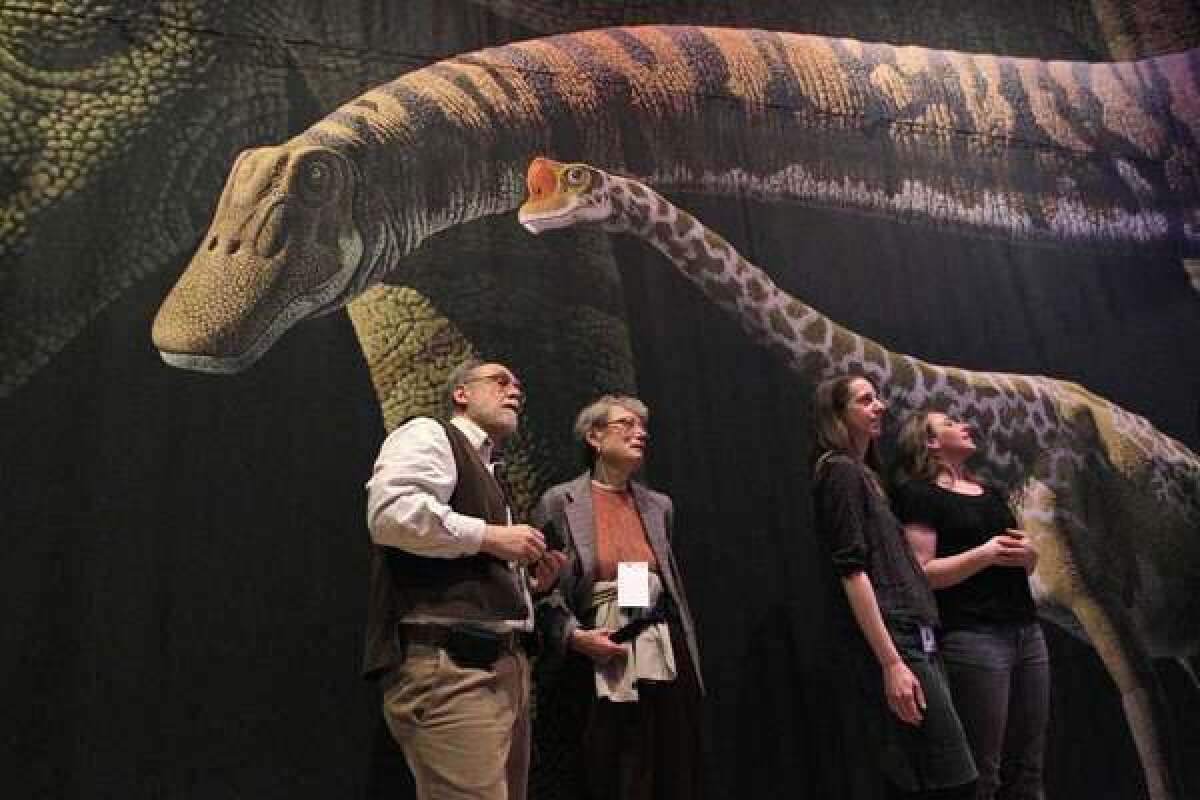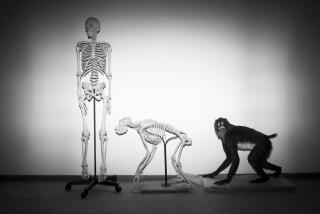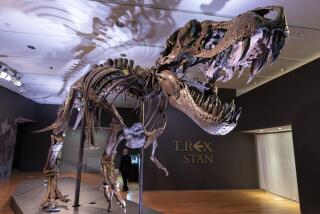Ostrich necks provide clues to how sauropod dinosaurs moved, ate

How did sauropod dinosaurs move their heads? When they stood, were their super-long necks stretched up high to the treetops like a giraffeâs? Set horizontal to the ground like a cowâs? Or in some other orientation as yet unimagined?
Many scientists have pinned their understanding of sauropod neck posture and flexibility on a groundbreaking computer model, described in a 1999 study in the journal Science. But a new study, published Wednesday in the journal PLOS ONE, suggests that model doesnât convey the whole picture because it doesnât fully consider how soft tissues like cartilage and muscle -- absent from dinosaur bones but available for study in extant animals -- might have influenced flexibility.
âNo one ever said, âLetâs apply this to a living animal,ââ said Matthew Cobley, a graduate student at the University of Utah and first author of the PLOS ONE study. âWhen we did, we saw it was totally wrong.â
Cobley, who did the work as part of his masterâs studies at the University of Bristol in England, decided to look at ostriches to gain insight into the sauropod biology. Scientists look at living relatives of dinosaurs, including reptiles and birds, to infer information about soft tissues in dinosaurs, Cobley said. In this case, ostriches provided the best analog for the sauropods because they also have long necks. (Giraffes, another obvious candidate for study, arenât as good a fit because mammals have significantly fewer vertebrae in their necks than sauropods and birds, he added.)
Cobley obtained three female ostrich necks and used an instrument called a goniometer to measure the angles formed at joints between vertebrae as he bent the neck as far as it could go. Taking measurements on the necks with muscles and cartilage intact and after soft tissues were removed, he discovered that the necks were less flexible with the soft tissues intact.
âThat demonstrates that a computer model that doesnât take soft tissues into account canât be adequate,â Cobley said. âWhen you look at extinct animals, you have to consider soft tissue.
âIf Iâm not looking at how soft tissue affects flexibility,â he said, âIâm not getting a idea of how flexible [the animal] is in real life.â
The computer models were so widely accepted that theyâve influenced depictions of sauropods on popular TV shows and in museum exhibits. Cobley said his research doesnât suggest a better way to position the necks in such presentations -- rather, it reminds scientists that they donât understand everything about how dinosaurs really stood.
âWe donât really know whatâs going on,â he said.
Debating the finer points of how dinosaurs stood or moved their necks can seem like a trivial pursuit, said Mathew Wedel, a biologist at the Western University of Health Sciences in Pomona, who has also researched the question. But itâs a detail of great importance to paleobiologists, who want to know how sauropods -- who thrived for some 150 million years -- lived so successfully on Earth for so long.
If scientists can understand what herbivorous creatures like Apatosaurus and Brachiosaurus were capable of doing with their long necks, they can speculate about their eating patterns and how species competed for food resources, said Wedel, who was not involved with Cobleyâs research.
âFor more than twice the length of the whole age of mammals, these guys were ... ecologically dominant,â Wedel said. âIf we want to understand Mesozoic ecosystems, we have to understand what sauropods were doing.â
Wedel praised Cobley for what he said was âa ton of workâ coming up with methods to gauge the neck flexibility, and said he hoped that scientists would now take the process Cobley developed and apply it to study other animals such as swans, cranes, llamas, giraffes and owls to look for patterns that might help paleontologists better understand sauropod anatomy.
Wedel said he had just submitted a paper for publication that suggested that sauropod muscles would have improved flexibility -- not hampered it.
âNow I have to change it,â he said with a laugh.






